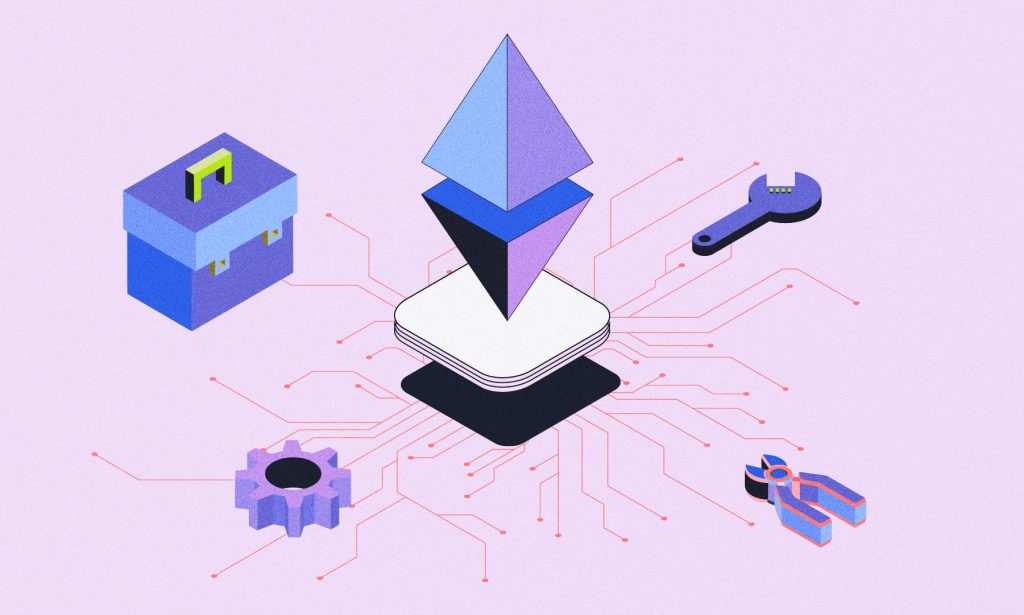Since its founding in 2015, the Ethereum blockchain has constantly implemented several upgrades to improve the protocol and prepare the network for future challenges. These innovations are brought in through Ethereum Improvement Proposals (EIPs) suggested by Ethereum developers and researchers worldwide and executed after much deliberation by the Ethereum community.
But what are Ethereum’s challenges? Well, slow transaction speeds and high fees during congestion times rank high on the list. Ethereum addresses these challenges one by one, as we have seen with the Merge, the Shanghai Upgrade, and the newest kid on the block, the Dencun upgrade that went live on March 13, 2024. This blog post focuses on some of those upgrades and puts things in perspective to better understand them.
Ethereum has put a plan in place to get things in order—the so-called Ethereum roadmap. However, before we analyze the Ethereum upgrades—-past, present, and proposed—let’s remember that upgrades or forks are essentially code updates. A code update is what goes behind an upgrade, of which there are two main types—hard forks and soft forks. Read on.
Hard forks
When changes are drastic, the blockchain network may split, resulting in two blockchain networks. This type of upgrade is known as a hard fork. When hard forks occur, the community divides into two—one supporting the pre-split version of the chain and the other the new version.
Some hard forks are intentional, while some are contentious. The latter often leads to a market shake-up. The Bitcoin Cash hard fork is an example. The Dencun upgrade is a hard fork.
Soft forks
Unlike the hard variety of forks, soft forks do not require a split as they are backward compatible. So, users may choose to implement the update without it causing any split. When people talk about upgrades, they often think of hard forks. However, soft forks play a vital role in the development of the chain.
You may have noticed that Ethereum’s recent “hard forks,” like the Ethereum Shanghai upgrade, do not result in a split in the chain. That’s because they are soft forks. The term hard fork is primarily used for public messaging to foreground the impact of these upgrades.
Ethereum soft forks are implemented via EIPs and ERCs. The journey from an EIP to an ERC leads to a soft fork like Shanghai, so let’s find out what these terms mean.
Ethereum’s latest upgrade – The Dencun upgrade
The Dencun upgrade is a significant milestone in Ethereum’s roadmap to become one of the best-decentralized blockchain platforms. It is Ethereum’s biggest upgrade since the Merge, the event that switched Ethereum’s consensus mechanism from the energy-intensive Proof of Work (PoW) to the greener Proof of Stake (PoS). The Dencun upgrade seeks to reduce transaction fees on layer-2 networks, improve Ethereum’s scalability, and provide a better platform for dApps and smart contracts.
The Dencun upgrade follows the Shanghai upgrade of March 12, 2023. The Ethereum Shanghai upgrade or Shapella upgrade finalized Ethereum’s move from a PoW to a PoS consensus mechanism. The most significant impact of this upgrade was the provision to withdraw staked ETH from the Beacon Chain.
The word Dencun is an amalgamation of ‘Cancun-Deneb’, as the Dencun upgrade contains improvements to the Ethereum network’s execution layer (Cancun) and consensus layer (Deneb). Cancun focuses on enhancing scalability and gas efficiency, while Deneb aims to bolster security and consensus mechanisms.
Furthermore, the upgrade introduces proto-danksharding, also known as EIP-4844, which scales the network via danksharding. Danksharding is a solution designed for Ethereum to achieve its full potential by dividing the Ethereum blockchain into smaller parts called blobs (Binary Large Objects). Data stored in blobs is automatically deleted after a set time, reducing data storage costs and transaction fees.
Dencun brings costs down for layer-2s
The Dencun software upgrade was hugely successful, helping to bring down costs for layer-2 networks such as Polygon, Arbitrum, and Coinbase Global’s Base. According to CoinDesk, the average cost of transactions on Optimism fell to about 4 cents from $1.4. Furthermore, the average fee on Coinbase’s layer-2 solution Base fell to 3 cents from about $1.50, while the fee on Arbitrum decreased to 40 cents.
The journey of EIP to ERC
Ethereum’s EIPs are like the Bitcoin Improvement Proposals (BIPs) of the world’s largest crypto by market cap. (BIPs are, in turn, modeled after Python Enhancement Proposals or PEPs.) They have the same purpose as BIPs: to bring innovation through upgrades. EIPs are how decisions regarding upgrades are made on the blockchain. These proposals are put to the vote.
If approved, the proposals lead to the creation of an Ethereum Request for Comment or ERC. An ERC means a new standard is established through an upgrade. All the project files and revision history are stored on a GitHub repository.
There are five stages through which an idea or an EIP leads to an ERC. They are as follows.
1. Idea or discussion thread stage
Developers working on Ethereum blockchain developments first initiate a discussion thread on the Fellowship of Ethereum Magicians. The purpose of initiating this thread is to avoid overlap with existing proposals or standards.
If the proposal is original and found useful, feedback is sought and documented as an EIP.
2. Draft stage
The documentation must include the technical specifications, features, and rationale behind the proposal. While drafting the proposal, the author can create a pull request. This allows the author to submit contributions to an open development project. After this, editors and reviewers are invited to provide feedback.
The editors will also guide the authors through the standard processes. If the proposal meets the guideline specifications, they will later change its status to draft.
3. Review stage
After editors and reviewers vet the draft proposal, authors are asked to continue auditing it. They must also document any foreseeable insights for future use cases. In this stage, the EIP moves from the draft to the review stage and is brought to the developers and community.
4. Last call
Once the author of the EIP is confident that no more changes are required, a final pull request is raised. This move brings the EIP to the final stage. At this point, the editors take a last call on the proposal and fix a deadline for the community to make suggestions. Beyond this date—usually in about two weeks—no changes will be entertained. However, the proposal returns to the review stage if significant changes are needed.
5. Final stage
After the last call period, the author creates another pull request to change the status of the EIP to indicate that it is ready for deployment. Once deployed to the mainnet, the EIP transforms into an ERC. The standard number usually follows the name of an ERC. For example, ERC-1155 or ERC-1559.
Currently, there are over 5,000 EIPs. Many of these proposals have been incorporated into the protocol, bringing many positive changes into effect. The list of all the ERCs can be found here.
Top five EIPs and ERCs
Many EIPs and ERCs, including the ones concerning the Merge, have played a key role in changing Ethereum’s course over the years. Here is our list of the top five.
1. ERC-20 token standard
Vitalik Buterin and LUKSO founder Fabian Vogelsteller proposed EIP-20 five months into the launch of the Ethereum mainnet in 2015. ERC-20 made the creation and issuing of smart contracts possible on Ethereum. It also set the standard for fungible tokens like ETH, including their transfer and spending by third parties.
Many token standards have been introduced over the years, but ERC-20 set the bar. Today, most tokens use it as a template, making it one of the most significant upgrades.
2. ERC-721 NFT standard
In 2018, William Entriken, Dieter Shirley, Jacob Evans, and Nastassia Sachs introduced EIP-721. The standard it introduced was added to the network in the same year. It addressed the limitations of ERC-20 by introducing the concept of non-fungibility. That means tokens would be given unique identities so they can be used to represent unique items. In other words, they enable the creation and transfer of Non-Fungible Tokens or NFTs.
This standard works by introducing a framework that allows ETH wallets to receive, track, and transfer NFTs and perform other applications.
ERC-721 enabled the creation of a new market, expanding the use cases of crypto. It also laid the foundation for the metaverse.
3. ERC-1559: Change in fee-burning mechanism in ETH 1.0 chain
The ERC-1559 change was the most discussed upgrade of all time. Its contentious nature was due to its aim to change ETH’s tokenomics, which means it altered the market’s supply of ETH. Proposed in 2019 and implemented in 2021, it is one part of the London hard fork.
Essentially, ERC-1559 introduced a fee-burning mechanism. That means it eliminated the guesswork of gas fees by introducing a block-wise base fee that one could calculate in advance. But why was it even required?
Well, a few years ago, the core team decided to reduce Ethereum’s block rewards. That meant miners would no longer receive 5 ETH. They would have to make do with 2 ETH. When that happened, miners began to up their gas fees to compensate for the decrease in earnings. This led to network congestion, which meant transactions with lower gas fees would take very long.
The ERC-1559 ensured Ethereum had made some significant fundamental changes to the fee mechanism. Before it was implemented, the reward consisted of the block reward and the transaction fee. With ERC-1559, the transaction fee paid in ETH is burned permanently instead. So, the miners now only got block rewards thereafter. (Now, this is staking rewards.)
To sum up, ERC-1559 decreased the supply of new ETH in the market.
4. ERC-3675: PoS upgrade
ERC-3675 can be regarded as a noteworthy upgrade in Ethereum’s history. The upgrade was proposed in mid-2021 and implemented on 15 September 2022. Vitalik Buterin, Danny Ryan, and Mikhail Kalinin proposed a change in the block structure, block processing, fork choice rule, and network interface. These changes facilitated the transition from the Proof-of-Work to the Proof-of-Stake consensus mechanism.
The mechanism change had been discussed for a long time, but EIP-3675 set the idea in motion.
5. ERC-1155: Multi-token standard
The ERC-1155 standard was built on the ERC-721 token standard. Its specialty was that it allowed the creation of both non-fungible and semi-fungible tokens via a single, smart contract. Before this, two smart contracts with different token standards would be necessary.
ERC-1155 set the stage for developing blockchain-based games, which need coins and collectibles.
This EIP was the brainchild of Witek Radomski, Andrew Cooke, Philippe Castonguay, James Therien, Eric Binet, and Ronan Sandford. It was also proposed in 2018.
Conclusion
In less than a decade since its inception, the Ethereum network has emerged as a byword for innovation in the crypto world. The flexibility to adapt to the growing demands is the hallmark of a dynamic system, and the Ethereum ecosystem has lived up to the hype. The Dencun upgrade significantly reduces transaction fees on layer-2 networks and improves Ethereum’s scalability. As the second-largest crypto by market cap begins the next phase in its evolution, it may be worth keeping track of the network’s history of game-changing upgrades.
FAQs
What is Pectra upgrade?
The Pectra upgrade is the next hard fork to be implemented on the Ethereum blockchain, scheduled for launch in late 2024 or early 2025. While the content of this fork has not been finalized, Ethereum developers have hinted that it would seek to improve wallet capabilities by allowing digital wallets to use smart contracts.
What is blockchain trilemma?
The blockchain trilemma is a term coined by Ethereum co-founder Vitalik Buterin that highlights the trade-off between security, scalability, and decentralization in blockchain technology. Many developers believe that achieving the perfect balance between the three is impossible, and improving one aspect means sacrificing another.








